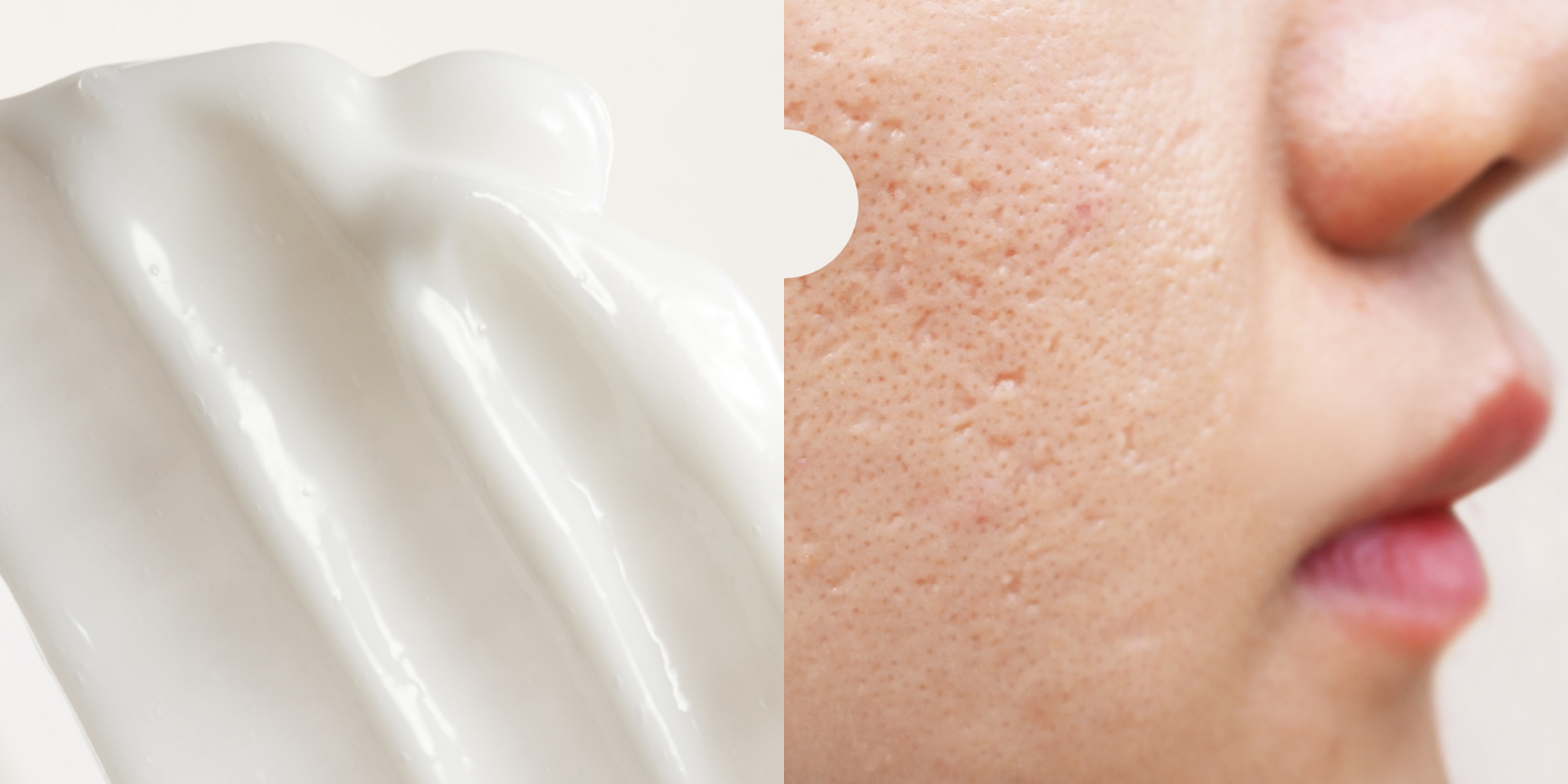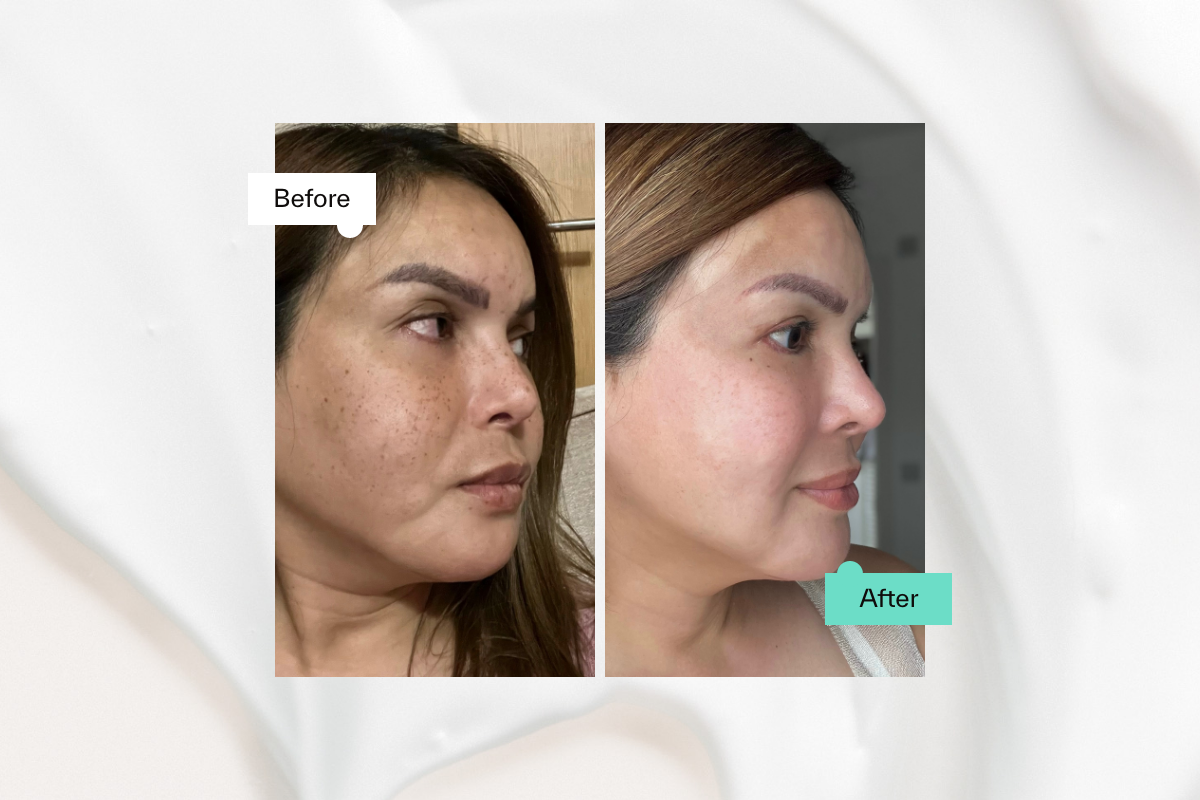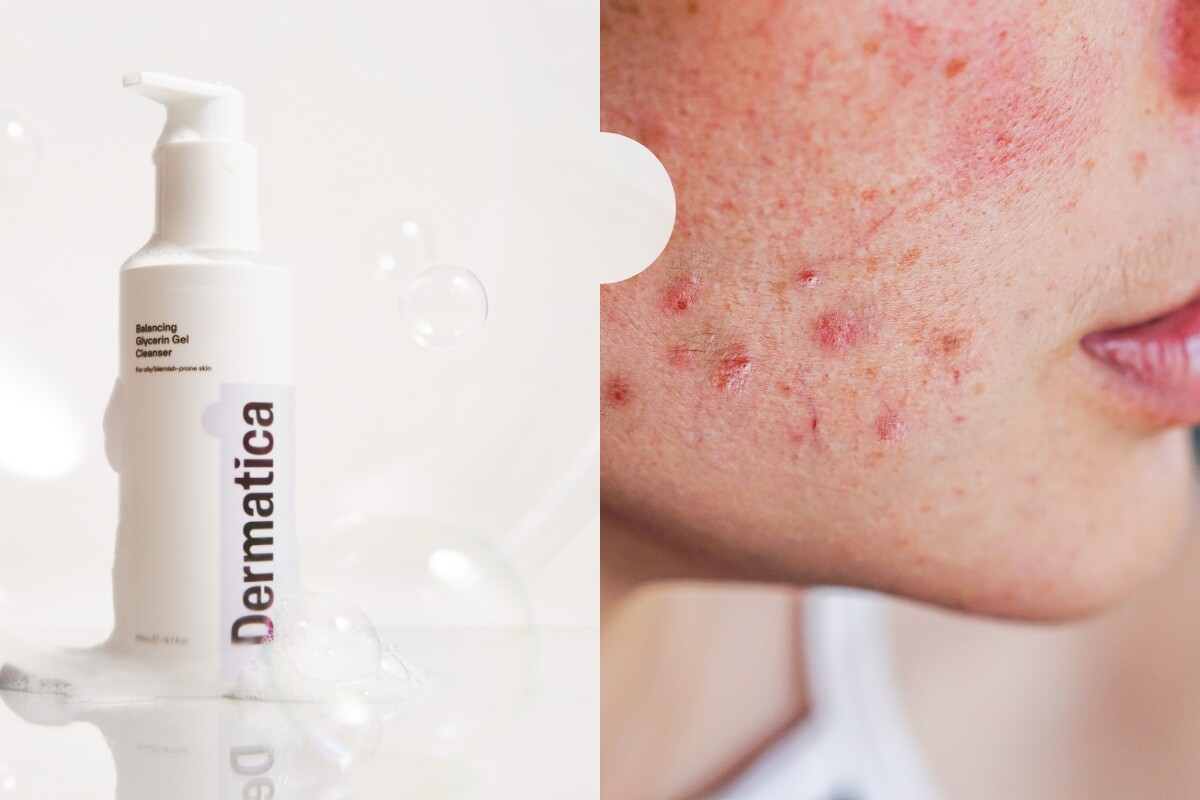Before we get into the treatment of acne scars specifically, let’s first explore what acne scars are and why they form in the first place.
Understanding Acne Scars
A scar (or cicatrix) can develop when the skin starts to heal from injury, inflammation or in the case of acne scarring – from breakouts. This commonly happens in cases of moderate to severe acne vulgaris, where the acne lesions were nodules or cysts. As with all skin concerns, everyone’s acne scarring will look and feel different. (1)
Types of Acne Scars
Atrophic Scars
Atrophic scars are recessed or depressed scars that occur below the surface of the skin. This type of scarring is caused by incorrect collagen production and degradation during the acne healing process. (1)
They can be categorised into icepick, boxcar and rolling wounds. As you’d imagine, ice pick scars extend into the deep dermis, and are V-shaped and narrow. Boxcar scars are wider, usually round or oval shaped with clearly marked vertical edges. Rolling scars are the widest and give the scars an undulating, shadowed appearance. (2)
Hypertrophic And Keloidal Scars
Unlike atrophic scars, hypertrophic are raised above the skin surface. (1) These scars form when too much collagen and keratin are produced during the healing process. You’ll identify a hypertrophic scar as it will be pink and firm to touch – and will be roughly the size of the acne lesion itself. While keloids extend beyond the edges of the original acne wound in reddish-purple papules and nodules. (3)
Peri And Post-Inflammatory Hyperpigmentation
Acne is an inflammatory skin condition, so can trigger a specific type of hyperpigmentation. Peri-inflammatory hyperpigmentation occurs while your skin still has active acne, while post-inflammatory hyperpigmentation (PIH) describes visibly darker marks left behind once the acne has cleared – caused by an overproduction of melanin. (4) And so can be treated in similar ways or alongside acne scarring.
PIH can take 6–12 months to clear completely on its own, but can usually be treated effectively using prescription actives that increase cell turnover and block melanin production in the skin.
Acne Scar Treatment
Before treating pigmentation, it’s important to clear any active acne on the face first. It’s worth remembering that topical treatments will only treat mild scarring – and moderate to severe acne scarring will need an in-person review with a dermatologist. They will then recommend a course of action which could include non invasive treatments, surgery or both.
Non-Invasive Treatment Options
Topical Treatments
Retinoids are considered the gold standard treatment for acne scarring and acne treatment. At Dermatica, our dermatology experts prescribe topical retinoid adapalene to improve mild to moderate rolling acne scars and PIH. Not only is it backed by decades of research, it has also shown to be gentle enough to use on sensitive skin types too.
Oral Antibiotics
Our dermatology experts will sometimes recommend a course of Doxycycline – an oral antibiotic – alongside topical retinoids to treat post inflammatory hyperpigmentation. An internal study we conducted found that participants taking oral Doxycycline had over 70% less post-inflammatory hyperpigmentation after 16 weeks. And more than a 50% improvement in PIH compared to those not using antibiotics.
Other Non-Invasive Treatments
For scarring that can’t be improved with topical retinoids alone (icepick or boxcar scars), there are a multitude of non-invasive treatments available including laser treatments and laser resurfacing, microneedling, dermabrasion, chemical peels, radiofrequency and the chemical reconstruction of skin scars (CROSS) technique.
Invasive Treatment Options
For individual scars that remain once topical and non-invasive treatments have been tried, there’s evidence to show the efficacy of dermatological procedures including filler injections, punch excision, punch elevation, subcision (inserting the needle under the scar to sever the fibrous tissue) or surgery. (2)
How To Prevent Further Scarring
Sun Protection
Whichever acne scarring treatment you use, the most important thing you can do is to protect your skin. Topical and non-invasive treatments are incredibly effective, but their removal of dead skin cells will leave the healthy new skin more vulnerable to photodamage. This could then lead to hyperpigmentation, dark spots and premature ageing. Our dermatology experts strongly recommend wearing a daily sunscreen SPF30+ every day, even on cloudy days, indoors and during winter months.
Skincare
If you experience new acne breakouts, remember it’s also possible to develop scars from prolonged inflammation of the skin – caused by the picking, scratching and squeezing of acne spots. So treating your acne early to avoid inflammation (and the temptation to
touch your skin) will help avoid future scarring too.
Find out what formulas are suitable for your skin by visiting our website.
References
1. Chilicka K, Rusztowicz M, Szyguła R, Nowicka D. Methods for the Improvement of Acne Scars Used in Dermatology and Cosmetology: A Review. Journal of Clinical Medicine [Internet]. 2022 Jan 1;11(10):2744. Available from: https://www.mdpi.com/2077-0383/11/10/2744
2. Connolly D, Vu HL, Mariwalla K, Saedi N. Acne Scarring—Pathogenesis, Evaluation, and Treatment Options. The Journal of Clinical and Aesthetic Dermatology [Internet]. 2017 Sep 1;10(9):12–23. Available from: https://www.ncbi.nlm.nih.gov/pmc/articles/PMC5749614/
3. Fabbrocini G, Annunziata MC, D’Arco V, De Vita V, Lodi G, Mauriello MC, et al. Acne Scars: Pathogenesis, Classification and Treatment. Dermatology Research and Practice. 2010;2010:1–13.
4. Lawrence E, Al Aboud KM. Postinflammatory Hyperpigmentation [Internet]. PubMed. Treasure Island (FL): StatPearls Publishing; 2023 [cited 2023 Jun 12]. Available from: https://www.ncbi.nlm.nih.gov/books/NBK559150/
Caroline Ferry
Caroline Ferry is a freelance journalist and copywriter, who has written for Grazia Magazine, Harper's Bazaar, Tatler and Elle and consults for many skincare, fragrance and fashion brands.
Ash Sharma
Dr Ashwin Sharma is a medical doctor and writer with a particular interest in health technology, artificial intelligence and medical weight loss. He completed his training at the University of Leicester and Imperial College London, and has since been exploring the intersections of medicine, technology, and communication.





